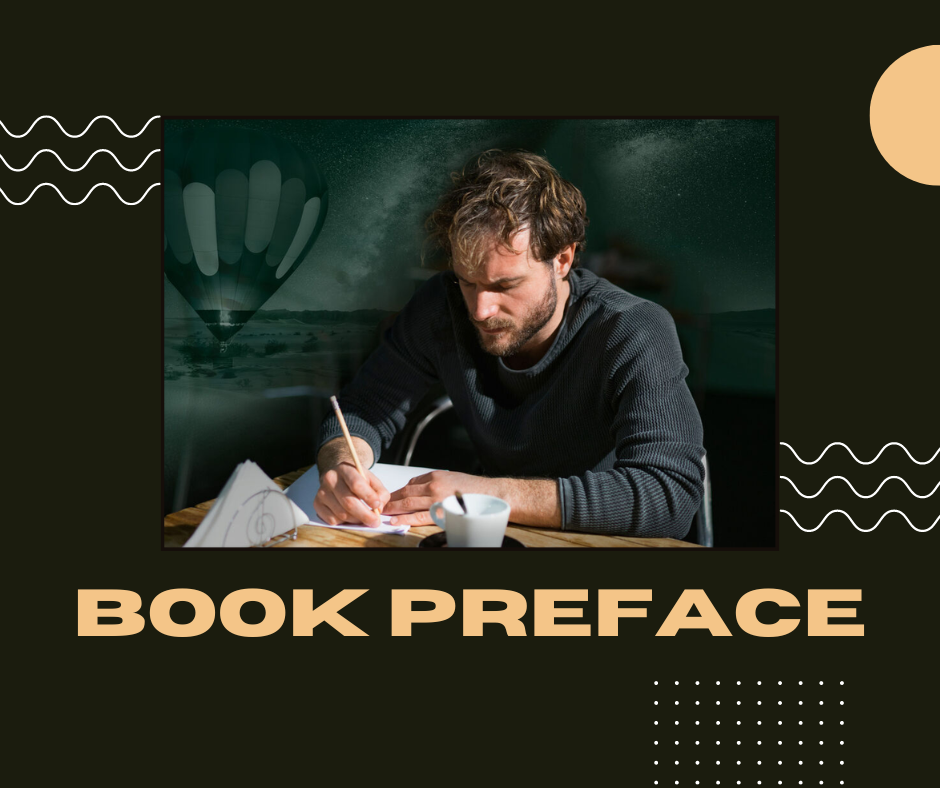
Book
As readers, we might overlook the pages at the beginning of a book, quickly flipping through them to decide which sections to explore. However, as authors or professional book writing services providers, understanding every component of the book, including those upfront, is crucial.
Among these elements is the book’s preface. You may not realize its significance without knowing what a book preface entails. Therefore, continue reading to learn about a preface and how to effectively write one for your book.
What Is a Book Preface?
A book preface is an introductory section that comes before the first chapter of a book. It allows the author to provide background information, acknowledge contributors, or explain their motivations for writing the book.
The main differences between a preface and a foreword or introduction are:
A foreword is usually written by someone other than the author, while the author writes a preface.
An introduction focuses on introducing the topic and structure of the book. Apreface has a broader purpose and can cover personal stories about writing the book, thank contributors, or provide context.
The writer of the book always authors Prefaces. Others may write forewords and introductions.
A preface comes before the first chapter. Forewords usually come after the table of contents but before chapter one. Introductions often serve as chapter one.
Prefaces are more personal in tone and relate to the writer’s experience. Forewords and introductions take a bird’s-eye view of the book’s contents.
Purpose of a Preface
The book preface serves several important purposes in a book. First and foremost, it allows the author to provide context and background for the book. This may involve explaining what motivated the writing of the book and what gap in knowledge or perspective the book aims to fill. It can also be what personal experiences inspired the author to tackle this subject matter.
For nonfiction books, especially, the preface is an opportunity to establish the author’s credibility and qualifications. The author can briefly share their expertise, education, or previous works that make them uniquely suited to address this subject.
Additionally, the preface gives authors a dedicated space to acknowledge and thank the key people involved in bringing the book to fruition. This may include manuscript editing services providers, agents, early readers who provided feedback, or family members who supported the writing process.
How to Write an Engaging Preface?
The preface is a great opportunity to grab readers’ attention and get them excited about reading your book. Make it interesting by telling a backstory that reveals something intriguing about the journey behind the book.
Share a funny anecdote or experience that inspired you to write on this topic. Adding a touch of humor and personality makes it more engaging. You could tell the story of when you announced you were writing a book, and your friend said, “That’s random; I didn’t even know you liked writing.” An amusing exchange like that allows readers to connect with you as a real person who undertook this book project for a reason.
The preface is less formal than the rest of your book, so feel free to get personal and let your passion for the topic shine.
Keep it short, honest, and entertaining. A compelling backstory draws readers in and excites them to learn more from you, the expert. Use those first few pages to connect with readers; they’ll be eager to hear what you have to share.
Here is how you can write the perfect preface for your book.
Length of a book Preface
The preface is typically a short section of a book. The preface will be 1-2 pages long for most novels and fiction. This keeps it brief so readers can jump right into chapter one.
The book preface may be a bit longer for non-fiction genre books and memoirs. Some run 3-5 pages. This allows more space to establish credibility, share insights into the writing process, or provide necessary context and background information.
Don’t let the preface become an overloaded introduction or seek to summarize the entire book. Keep it focused to achieve its purpose without delaying the start of the main content.
Voice & Tone
The preface is generally written in first person since it’s a personal note from the author to the reader. It has a conversational and familiar tone like the author speaks directly to the reader.
Some tips for achieving the right voice and tone in your preface:
- Use “I” and “you” frequently to address the reader directly. For example, “I wrote this book to help you understand…”
- Write in a casual, conversational style. Avoid overly formal or stiff language.
- Share personal stories or anecdotes if relevant. This helps connect with the reader.
- Express your passion or insight about the topic to capture interest.
- Use humor cautiously. A witty or light-hearted preface can engage readers, but don’t overdo it.
- Convey sincerity and genuineness. The preface sets the tone for the entire book.
- Imagine you’re speaking to a friend or person you trust. Capture that same warmth and openness in your writing voice.
The preface is your chance to establish a relationship with readers. An inviting, conversational voice and tone help achieve that. Keep it friendly and authentic.
What to Include
The preface is a great place to provide some background on your motivations for writing the book and the key people who helped make it possible. Here are some details to consider including:
· Background on Writing the Book
When you’re crafting a book, how do you develop the idea for it? Was there a specific experience or moment of inspiration that sparked it?
What goals or purpose do you have for the book? What do you hope readers will take away from it?
What challenges did you encounter during the writing and publishing process? This helps readers understand the full backstory.
. Thanking Key People
Your book preface is a good opportunity to express gratitude to people who helped support you in writing the book. This may include:
- Your editor, agent and publisher
- Friends or family who provided feedback on drafts
- Subject matter experts who reviewed specific sections
- Colleagues who offered advice or encouragement along the way
· Overview of Topics Covered
- Provide a high-level overview of the key topics, concepts and ideas covered in the book. This helps set the stage for readers.
- You can summarize the book’s overall scope and call out noteworthy chapters or sections readers will find.
- This overview helps readers understand the book’s insights before diving into chapter one.
The preface provides useful context to help readers better appreciate your book. Use the space to share your motivations, thank key supporters, and preview the content.
What to Avoid
The book preface should avoid certain elements that can detract from the reader’s experience.
· Major Spoilers/Plot Reveals
Don’t reveal the main story’s major twists, surprises, or spoilers. The preface should avoid giving away pivotal moments that the reader will encounter later. Even subtle hints or clues about the plot development should be left out of the preface.
· Detailed Summaries of Chapters
Don’t use the preface as a place for lengthy chapter-by-chapter summaries. The preface is not meant to be a detailed overview of the book’s contents. At most, briefly mention the broad progression of topics/themes without delving into specifics.
· Bloated Background
Avoid excessive background information or context setting in the book preface. Remember, the purpose is to introduce the book and entice the reader – not educate them on the subject matter. Too much background comes across as heavy-handed and risks losing reader interest quickly.
Formatting Tips for Book Preface
The book preface should follow the same formatting style as the rest of your book to create a cohesive reading experience. Here are some formatting tips from our professional writers at the Ghost Writing Founders:
- Include the word “Preface” at the top of the page to clearly label this section. You may center or left-align it.
- Use the same font and font size as the rest of your book. This helps the preface seamlessly blend in.
- Single space the text with paragraph breaks between sections. Avoid large blocks of text.
- Format any headers/subheaders the same as in the book. This creates consistency.
- Italicize any book titles mentioned.
- Insert page breaks before and after the preface to separate it from other front matter.
- Don’t paginate the preface with numbers. Let it stand alone, separate from the main narrative.
Keeping the preface formatted like the rest of the book helps it feel like a natural component versus a tacked-on afterthought. Use the same stylistic choices to immerse readers.
Conclusion:
Mastering writing a book preface is a crucial skill for authors in 2024. Following the guidelines outlined in this guide, you can create an amazing preface that engages readers, sets the tone for your book, and enhances the overall reading experience.
For fiction books, skipping the preface is acceptable. You can add one in future editions if your book gains global recognition. Nonfiction authors, however, should ponder their unique writing journey. If notable, craft a brief, engaging preface sharing intriguing facts and your passion with readers.
Remember, your preface is your opportunity to connect with your audience, share your journey as an author, and provide valuable insights into the themes and content of your book.









Leave a Reply